Content is the lifeblood of digital communication. Whether you write a blog post, record a podcast, or share a video on Instagram, all these pieces of information let you achieve various goals:
- Connect with the audience
- Promote goods and services
- Establish your brand identity
However, content takes lots of patience, time, and resources. Various marketing specialists are deeply involved in this process, including copywriters, social media managers, and email marketers, to name a few.
These professionals might have continued planning their content strategies in the usual way if it weren’t for the emergence of a game-changing technology. Yes, we’re talking about artificial intelligence (AI). Since its early stages, AI has been simplifying the work of content professionals, boosting their efficiency and increasing the volume of content generated in a minute.
One of the most notable advancements in this field is generative AI. Tools like ChatGPT, Jasper (for text generation), and Midjourney (for image creation) can respond and produce the needed content in seconds.
In this ocean of information, the key question is: How can your content not just survive but thrive? The answer lies in embracing automated content generation through AI tools. Automated content generation brings numerous benefits, from greater efficiency to enhanced precision. In this article, we’ll discuss how to automate content creation with AI. We’ll also share tips on content distribution, personalization, and analysis.
AI in Automated Content Creation

Automated content generation has advanced so much that it no longer means robotic, uninspiring text. Today, algorithms create engaging and human-like material that is hard to distinguish from human-generated texts, images, and videos.
Automated Content Generation Redefined
Content automation tools powered by AI, machine learning (ML), and natural language processing (NLP) are crafting coherent, informative, and contextually relevant content. And the best part is that they rely on vast databases, storing information no human can remember. As such, it’s like an educated professional with deep knowledge in different fields, such as finances, medicine, IT, and so on.
Of course, we need to mention platforms like OpenAI’s GPT-3.5 and 4. This tool has quickly become the most popular application in history, breaking records in the number of users attracted at such a rapid speed. What contributed to such success? The reason is that they communicate with users like humans, creating texts for various purposes:
- Long reads
- Short social media posts
- Outlines
- Schedules
- SEO keywords
- Recipes, and much more
Here is what the tool itself says about its capabilities in content marketing:
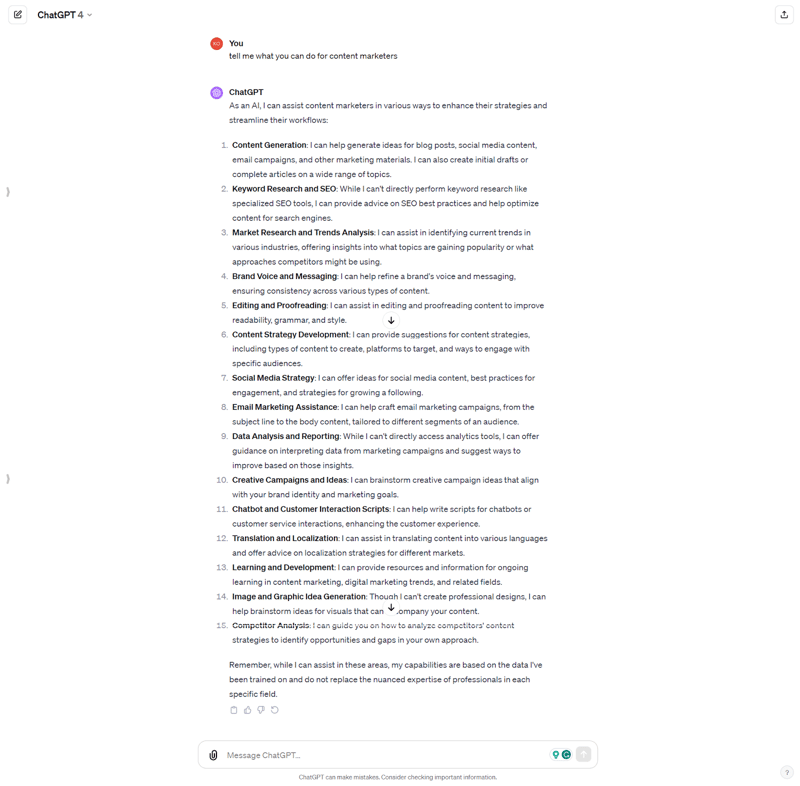
Screenshot taken on the official ChatGPT website
ChatGPT outlines how it can help content marketers
You can ask it to write in a particular language, style, and way to resonate with your target audience. It adjusts to your needs and preferences, analyzing existing internet data to produce original, SEO-optimized content. Moreover, making the content more accessible to diverse readers is one of the ways to optimize UX (user experience). By doing so, you increase customer satisfaction and content reach.
But it’s not all about blog writing. AI is equally proficient in generating data-driven reports, personalized email content, and creative fiction. It combines data analysis with a nuanced understanding of human language, bringing high-quality and human-like content. Among other noteworthy AI-driven tools for content marketing are:
|
Jasper |
Similar to ChatGPT with a user-friendly interface. Provides functionality to adapt to different tones, styles, and a variety of brands and industries. Produces high-quality SEO-focused content, ad copy, and product descriptions. |
|
Writesonic |
If you want to create digital advertising and marketing content, this tool is for you. You can use it to get SEO-optimized ad copy, landing pages, and product descriptions or leverage its text-to-speech and voice AI capabilities. |
|
Copy.ai |
Perfect for blog content, email marketing, social media posts, and other short-form material. |
|
Grammarly and Hemingway Editor |
While these can’t write texts, they have integrated AI capabilities to analyze content, highlighting grammatical, readability, and engagement issues. |
Automated Content Creation Dynamics
It’s fascinating yet worrisome to witness how automated content creation develops. When ChatGPT entered the market, it evoked fears and images of robots taking over human jobs. Lots of layoffs around the world have also contributed to this picture. That’s understandable. We see a shift from manual, time-consuming content creation processes to automated, efficient, high-quality output.
In some cases, robots can indeed perform tasks better than people. They analyze information in no time, don’t need rest, and cost less than paying someone a salary. However, they can’t replace professionals with their analytical skills.
While ChatGPT can understand the context, it may lose it after some iterations. It also has a limited database, gets outdated, and may come up with fake information. That’s why you need to fact-check after it, and it won’t replace humans. At least for now.
Moreover, it’s available to billions of people worldwide, so its information may appear elsewhere. With more and more generations, you’ll find similar patterns in AI-generated texts. For example, it may use similar expressions in various contexts. Or it may not go deeply into details providing basic information. These texts will be unique and informative but will lack the essential originality and style inherent to humans.
AI-driven content creation tools are increasingly used for not just text-based content but also for visual and audio content. AI algorithms can now assist in creating visually appealing graphics or editing videos. They can also transform your texts into audio and videos, so you don’t need to record them yourself with all the associated difficulties, such as:
- Looking for a voice actor
- Purchasing video/audio recording software and hardware
- Editing the video/audio, etc.
Furthermore, AI is essential for personalization, especially at scale. In the next section, we’ll go into more detail about AI for content personalization.
In essence, AI offers new ways to connect with the audiences with minimal effort and maximum impact. Content creators spend less time generating ideas or overcoming writer’s block, using AI to deliver meaningful and memorable content. One thing is clear: the future of content is here, and it’s more dynamic and exciting than ever. Let’s continue to explore the vast potential of AI in content creation.
Automated Content Generation and Audience Engagement
Why You Need an AI Content Creation Tool for Personalization
Personalization has become pivotal in 2024, with 90% of leading marketers linking it to company profitability. If your business and customer list is small, you may remember their preferences and personal details and adjust communication accordingly. But as more clients will come to you, AI will be indispensable for certain personalization tasks, such as:
- organizing “You May Also Like” sections with relevant product recommendations if you’re an online retailer, like these in the screenshot below:

Screenshot taken on the official Umbra website
Smart product recommendations on the Umbra website based on your previous views
- Crafting emails where you not only use the recipient’s name but also offer pertinent goods and services according to their purchase history or provide analytics of their interactions with your company
- Customizing blog posts, videos, and other forms of content for different audiences
- Enhanced chatbot conversations, offering product recommendations, support, and guidance based on the user’s past behavior and preferences
Consider an eCommerce website that personalizes each visitor’s homepage according to their browsing history. Or imagine a blog that adjusts its recommended reading list depending on what the visitor has previously liked. With AI, you ensure content that feels like it was crafted just for this or that person. It lets the audience feel understood and valued, leading to higher engagement, loyalty, and conversion rates.
Content Automation Marketing Successes
Now, let’s look at real-world examples of businesses leveraging AI-driven personalization. One of the first companies that may come to your mind is Netflix. The streaming service revealed that 80% of its content is delivered through its AI-powered recommendation engine. For a user to get tailored offers, the system analyzes the following data:
- Viewing patterns
- Ratings given by others
- The time of day when people watch shows
Or take an email from Priceline as an example. The travel agency provides a summary of the user’s travel activities over the past year. It’s one of the best ways to personalize email content, creating a bond with the client and the company.
This email reflects the person’s experience, making it more interesting for the recipient and raising the chances that they’ll interact with it. It also shows the company pays attention to the customer’s needs and history. And who wouldn’t want to experience VIP treatment?
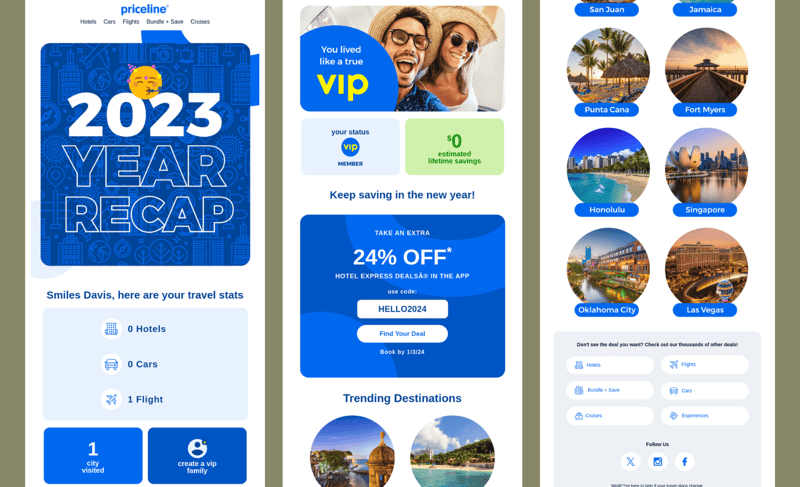
Screenshot taken from the newsletter from the official Priceline website
A personalized travel year recap from Priceline
Strategic Automated Content Distribution
Once you’ve created content, you need to distribute it. That’s where AI-based content automation tools may also help. The thing is that you don’t need to post an image or text and wait for people to click. You need to be present where it matters most and remind customers of yourself at the best time when the audience is the most engaged. Below is how AI helps ensure your content reaches the needed people at the right time.
How to Automate Content Creation for Reach
To understand how AI maximizes content distribution efficiency, let’s look at two media: social networks and email newsletters. AI algorithms can calculate the following on social media:
- The best times to post
- The right frequency
- The most engaging content formats for different platforms
They let you make data-driven decisions for maximum impact. Suppose an AI tool has analyzed social media patterns and found that your audience is most active on Tuesday evenings and prefers video content. Now you understand why your Friday Stories don’t generate the desired effect. Based on the findings, you can target the audience more precisely, increasing the chances of your content being seen and engaged.
Artificial Intelligence has also changed email marketing. The era of universally applicable email blasts is over. These days, audiences can be divided into groups according to their past interactions with emails, how they use websites and even their past purchases.
As a result, open rates and engagement will rise because every recipient will get an email that feels customized just for them. According to Campaign Monitor, marketers who employ segmented tactics report revenue increases of up to 760%.
Content Creation Automation in SEO
When it comes to SEO, AI focuses on predictive analytics. As such, you don’t just respond to changing trends but create content that will rank well immediately after publishing it. Traditionally, SEO has been about reactivity. You need to understand and adapt to search engine algorithms. Now, we can anticipate and prepare for updates and trends with AI.
SEO automated content generation tools can analyze vast amounts of data from search engines to predict trends like:
- Which keywords will become more relevant
- Which topics are gaining traction
- What kind of content formats will be favored by search algorithms
Moreover, AI goes beyond inserting keywords into texts, as Google no longer appreciates stuffing them. These tools can optimize content for relevance and user intent for people to get value from the page they’ve landed on. Tools like Semrush’s SEO Writing Assistant and Surfer AI rely on artificial intelligence to enhance SEO, offering advanced insights on aspects such as:
- Content quality
- Readability
- Tone of voice
- SERP competitiveness
Analytics in Automated Content Generation

The content is live. It brings visitors to the website, and someone even orders your products and services. How do you know that it’s due to the content? Or maybe you need to tweak it to drive better outcomes. You need to analyze its performance. Let’s explore how AI makes sense of numbers and estimates the impact of your content as you create it.
Content Automation Tools for Insights
AI-powered content automation tools dive deep into content performance analytics, providing clear insights into what’s working and what’s not. For instance, AI may measure social media shares, time spent on a page, click-through rates, and other user engagement data. According to various reports, high-performing marketers are more eager to use AI in their marketing analytics. But why exactly AI? The power of such technology lies in its ability to do what humans won’t ever be capable of:
- Process and analyze vast amounts of data;
- Ensure precision and speed that manual analysis simply can’t match.
AI in analytics helps fine-tune content strategies, ensuring resources are invested in the right type of content.
Automated Content in Market Segmentation
Segmentation is all about dividing the audience into groups with similar characteristics, such as age, interests, gender, etc. That’s where AI also shines. AI-driven tools transform the understanding of different market segments into actionable strategies in the following ways:
- Analyzing consumer behavior patterns: Large datasets contain millions of subtle patterns and trends that can influence consumer behavior. AI capabilities built into Adobe Analytics or Google Analytics allow you to spot them. For example, some blog topics may be more popular among millennials than others. Or if you target Gen Z with videos, AI tools may identify the most appealing type of product clips.
- Segmentation based on diverse factors: Even people from the same demographic category may have different preferences. And vice versa, consumers may be interested in the same items even if they’re of various ages and genders. That’s where browsing history may be a valuable source of information.
AI solutions use it to discern potential upselling opportunities. They also interpret sentiment in social media interactions to answer the question, “How does my brand position itself online?” You can utilize a tool like Sprout Social to perform this task to reveal which products or services are receiving positive feedback and which are sparking inquiries. - Tailoring content for specific segments: Imagine a music streaming service similar to Spotify. It heavily depends on AI to analyze listening habits, genre preferences, and even the times of day when certain music is preferred. This information enables the creation of personalized playlists and song recommendations so that a rock fan wouldn’t be bombarded with electronic music, for instance.
This way, users can discover new music that aligns with their tastes. This level of personalization increases the chances of users coming back. They might think, “Ok, what’s in it for me today? This app understands me very well.” And that’s crucial for enhancing loyalty and retention. - Empowering human creativity: AI doesn’t compare to humans in terms of generating creative stuff. That’s why it won’t replace humans despite rising fears among content creators. It can’t get references, memes, and cultural nuances with the comparable finesse and understanding as people can.
What it’s capable of is empowering you to develop something better, more resonating, and engaging. It provides the knowledge necessary for tailoring the creative strategy, such as what works best for each audience segment.
Automated content analysis is like having a silent but smart, data-savvy assistant. It can’t replace the human element in content marketing but enriches it with insights that only a machine can provide.
Challenges in Automated Content Generation

Balancing Automated Content and Creativity
Once you start using AI in content marketing, especially generative AI tools, you may think, “Where is the line between automated content and human creativity?” AI tackles problems such as data handling, SEO optimization, and content generation. However, it’s all basic and lacks humans' innate creativity and emotional intelligence.
That’s why we advise you to employ AI reasonably. For example, ask it to generate a content plan or outline but refine it with your knowledge. You can outperform an AI content creation tool by telling real-life anecdotes to your consumers, sharing your experiences, and giving personal recommendations.
AI can generate a news article based on facts and figures; that’s true. Yet, it may struggle to capture the human element that makes stories compelling and relatable. The solution? Don’t replace the human aspect with AI. You need to boost efficiency, not lose your distinguishing features.
Ethical Aspects of Automated Content Generation
There are two main ethical issues with developing AI models:
- If they learn from data, how do you legally collect it?
- The quality of AI output depends on the data it was trained on. If the data is biased, so will become the AI model.
First, let’s talk about data privacy and several high-profile lawsuits. These legal disputes bring to light important issues with artificial intelligence and intellectual property rights.
- The New York Times lawsuit: The publisher has accused the creators of ChatGPT and Microsoft’s Copilot of using content from various outlets, including their own, to train the tools. It can divert web traffic and ad revenue from the copyright holders. This case highlights that AI may influence original content creators and how they earn money.
- Lawsuits from renowned authors: OpenAI has found itself in another lawsuit with a group of novelists, including John Grisham, Jodi Picoult, and George R.R. Martin. These authors have raised concerns about the company’s use of their works. These allegations make us think, “Can we use existing intellectual property to train AI systems and how?”
- Concerns from nonfiction writers: Similarly, nonfiction writers, including a Pulitzer Prize-winning author, have filed a lawsuit. They also fear that artificial intelligence (AI) in its current form may be able to use their intellectual property without any limitations.
These cases center on the argument that OpenAI’s products are built on the intellectual property of others. We may conclude that OpenAI is just one example but not the only one, as there are dozens of similar companies working on generative AI development. This brings to light the critical issue of data protection.
OpenAI has responded that they use publicly available content, so it’s fair use. This answer has highlighted a crucial discussion in the field of AI ethics: where is the boundary between fair use and infringement?
Moreover, AI will reflect the biases in the data it was trained on. It may lead to misrepresentation, unfairness, gender stereotypes, or using outdated terms that may seem offensive.
Best Practices in Leveraging the Automated Content Strategy

Incorporating an AI Content Creation Tool
Let’s assume you’ve decided to introduce AI into your content marketing. That’s great. To make it easier for you, let’s overview the process of starting with automated content creation:
- Define what you want to achieve. Having a clear objective will determine what tool you need. For example, you may want to improve SEO, increase engagement, or automate routine tasks. Each goal is better achieved with a dedicated tool.
- Explore tools for AI content creation. For SEO-automated content generation, consider Semrush. To refine the quality of written content, try Grammarly.
- Train your team. Your team should be able to manage AI tools. Launch training sessions to educate employees and make them comfortable with the new technology.
- Integrate AI gradually. Don’t make sudden changes to the whole content strategy. First, automate one or two processes, measure the results, and then expand. This way, you progress to the new environment seamlessly.
Automated Content Creation Pitfalls
With all its advantages, AI has its disadvantages that may impact the content quality. You need to address these problems. Luckily, it doesn’t require advanced skills.
The first pitfall revolves around producing generic and formulaic content. If you’ve been using any AI content creation tool already, you may have noticed that they usually utilize the same words in different contexts. For example, ChatGPT likes words such as “powerhouse”, “a treasure trove”, “evolving landscape”, etc.
Consider the following scenario: You want the tool to write a social media post. If you just copy and paste the output as it is, you may find that your text looks like hundreds of others. It may not produce the desired effect on your target audience.
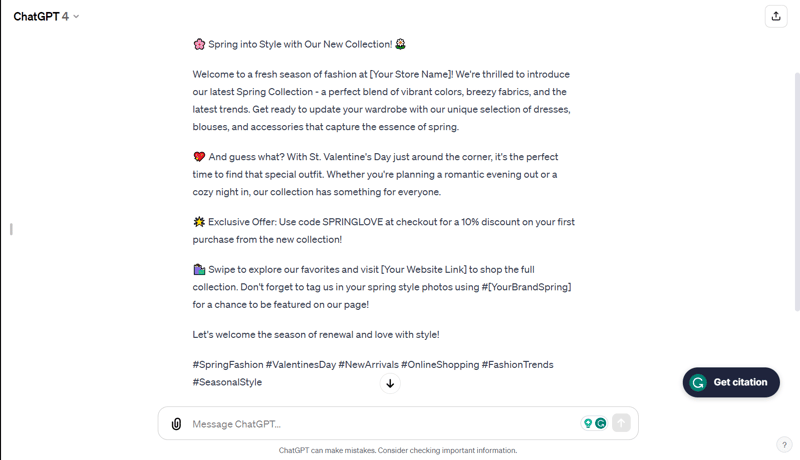
Screenshot taken on the official ChatGPT website
ChatGPT has crafted a social media post for a fashion retailer’s Spring and Valentine’s Day collection
Tip: Infuse unique brand elements into AI-generated content. This might involve customizing templates or adding brand-specific phrases.
Other pitfalls any business may encounter include:
- Misalignment with audience expectations. It’s when AI doesn’t fully grasp your audience's evolving expectations and preferences. It may produce technically accurate and SEO-friendly content but overlook current trends that a human marketer would catch.
- Not regularly updating the database. It may lead to the problems discussed above (bias, stereotypes, and the like). Periodically provide the AI models with refreshed data to keep the content relevant and effective.
- Neglecting SEO optimization. SEO AI tools also require human oversight. Complement them with an SEO specialist’s expertise for the website to rank as high as possible.
- Overlooking data privacy. Choose tools that comply with regulations like GDPR. Notify customers of using their data and provide an option to restrict access to their information.
Conclusion: Embracing AI in Content Creation Automation
AI advances in the realm of content generation by leaps and bounds. It eliminates such problems as creative blocks, language barriers, and slow content production. Content automation tools have shown such good results that they have even raised questions about AI replacing humans at work.
And we totally get why. Such precision, speed, and quality are the most critical AI strengths. However, what’s automated may soon become too robotic. As you create content for humans, you should double-check whether it resonates with them. And that’s where content professionals are indispensable.
To conclude, using AI in content marketing is a must. The earlier you get a grasp of such tools, the sooner you’ll elevate your content management processes. On the other hand, don’t rely on AI too much to the extent that it threatens to become the only team member. Value customer privacy, simplify mundane tasks with AI, and let your content shine.

Katie Parish
Kate Parish is a chief marketing officer at Onilab. She has almost a decade of experience in the company and is still enthusiastic about every aspect of digital marketing. Kate sees the marketing mission as ensuring sustainable business growth. For this purpose, she helps companies and readers create efficient campaigns, solve common problems, and enhance crucial website metrics, such as conversions, bounce rates, and others.










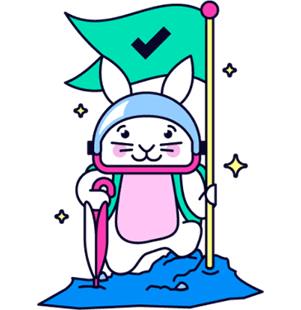
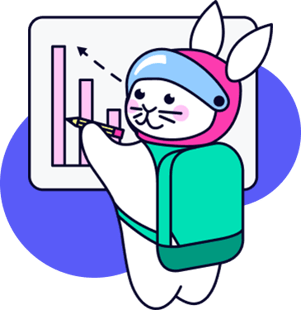

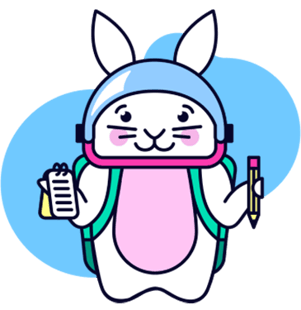


2.png)
2.png)




